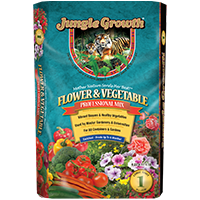Harvesting season is coming up for many of your summer fruits and vegetables. Knowing when to harvest, how to harvest, and what to look for is imperative for a long and successful growing season. Follow these simple tips to enjoy your fruits and vegetables all summer long!
Apples:
You can tell an apple is ready for harvest due to its color of the outer peel and seeds. Should be harvested from midsummer to late fall depending on the type. Gently lift and twist to remove the apple from the tree.
Asparagus:
If your asparagus plants were planted from crowns, you should be able to harvest lightly for a week or two in the spring of the second season. If you wait until the third season though, the plants will be better established. The third year you can harvest for 3-4 weeks and pick for 6 weeks or more every year after. Make sure you pick sparingly the first time.
Snap Beans:
Harvesting can be done when pods are firm, crisp, and are about as thick as a pencil. When you break them in half, they should actually snap! To remove, hold the stem with one hand and the pod with the other, this way you don’t pull off the branches that will produce more plants. You can use scissors or your fingers to remove the pods.
Shell Beans:
Pick these when the pods change color and the beans inside are fully formed but not completely dried out. They should be plump, tender, and firm. Pick every couple of days; be sure to not leave them on the plant for too long.
Dried Beans:
Pods should get as dry as possible and should be picked when they turn brown. You should be able to hear the seed rattling inside the pod. If weather is too damp, harvest and hang indoors to dry. Beans should remove easily due to the fact that they are dry.
Broccoli:
Heads should be a deep green during harvesting. They should be compact and they should be harvested before the buds start to open into flowers. Harvest immediately if yellow petals start to show. To remove, cut the stem 4-6 inches below the head at an angle.
Cabbage:
You can tell it is ready to harvest when the head is full and firm. To remove, cut the stalk at the base of the head. Use a sharp knife and discard the outside leaves. It is best to harvest during the early morning.
Carrots:
Usually carrots are ready for harvest in 2-3 months or when they are large enough for use. To remove, loosen the soil and gently pull them out of the ground. To make it easier, you can water prior to harvesting. You can leave carrots in the ground until you need them because they will not overgrow or go bad.
Cauliflower:
Harvesting should be done when heads are full but before the curds begin to separate. To remove, cut through the stump under the head. Be carefully not to bruise the curds, they do so easily.
Corn:
Look for dark brown and soft silks when harvesting. Corn should be picked in the late afternoon because it is when they have highest amounts of sugar. To remove, twist the ear off of the plant in a downward direction.
Cucumber:
Harvest when the cucumber is medium to dark green in color. It should feel firm when squeezed. It is better to pick cucumbers when they are smaller (5”-8”) so the vine can produce more, extending the growing season, and so the cucumber doesn’t become overripe.
Honeydew:
Keep a close record on your honeydews maturity date and be sure to not remove until then. They are often difficult to tell if they are ripe or not.
Lettuce:
Head lettuce matures in about 70 days whereas leaf lettuce matures about 40 days from seeding. You can remove heads when they are firm. Make sure to cut the plant from ground level.
Muskmelon/Cantaloupe:
Muskmelons are ripe when the rind is tan rather than green. Many will also have a strong melon fragrance because they will have produced all their special sugars. The surest sign is when a crack forms on the stem right near the point of attachment. The fruit should basically slip off of the vine when ripe, so if you have to work hard to remove it then it isn’t ripe.
Okra:
Okra pods are ready to harvest when they are 2”-3” long and snap easily. Over-mature pods become tough and woody.
Green Onions:
Harvest green onions anytime after they reach 6” and bulbs are no more than ½” in diameter.
Pears:
Pears should be harvested when they are completely mature. They are ready for harvest when the green color lightens and the stem parts from the spur easily when lifted. You can check the neck for ripeness by applying gentle pressure to the stem end with your thumb; it is ready to eat if it yields pressure.
Snow Peas:
Harvest when pods are fully developed but before pea seeds appear. You do not want the pod to fill out.
Bell Peppers:
Harvest peppers when the fruits are 4”-5” long and firm to the touch. Pick bell peppers more frequently earlier in the season so your plant will produce more peppers for the duration of the season. If you want red peppers, don’t pick them until they have fully ripened and started to change colors.
Hot Peppers:
Harvest peppers as needed throughout growing season. If you want hotter peppers, harvest when they are young and green vs. mature and colored.
Potatoes:
It is time to harvest when the plant’s stems and leaves turn brown. They should be removed when they reach the desired size. Simply pull up the brown foliage and use your fingers to find the potatoes within the soil. If soil isn’t lose use a pitchfork to loosen it before removing.
Rhubarb:
Harvest when the leaf stalks are between ½”-1” in diameter.
NOTE: Do not use the leaves!
Spinach:
Harvest when the leaves are appropriately sized for eating. Break off the outer leaves as the plant grows or harvest the entire plant at once.
Summer Squash:
Harvest when squash is young and tender. The skin should be easy to penetrate with your fingernail.
Watermelon:
You can tell that watermelons are ripe when the tendril at the stem end dries to a brown. The bottom of the melon will also turn yellow and cream colored. The shell should be difficult to penetrate with your fingernail.










